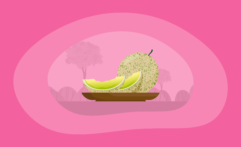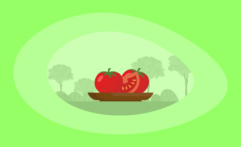7 Least Sustainable Fruits: The Complete List
Impactful Ninja is reader-supported. When you buy through links on our site, we may earn an affiliate commission.
Learn more
Learn more
.
Hey fellow impactful ninja ? You may have noticed that Impactful Ninja is all about providing helpful information to make a positive impact on the world and society. And that we love to link back to where we found all the information for each of our posts. Most of these links are informational-based for you to check out their primary sources with one click. But some of these links are so-called "affiliate links" to products that we recommend. First and foremost, because we believe that they add value to you. For example, when we wrote a post about the environmental impact of long showers, we came across an EPA recommendation to use WaterSense showerheads. So we linked to where you can find them. Or, for many of our posts, we also link to our favorite books on that topic so that you can get a much more holistic overview than one single blog post could provide. And when there is an affiliate program for these products, we sign up for it. For example, as Amazon Associates, we earn from qualifying purchases. First, and most importantly, we still only recommend products that we believe add value for you. When you buy something through one of our affiliate links, we may earn a small commission - but at no additional costs to you. And when you buy something through a link that is not an affiliate link, we won’t receive any commission but we’ll still be happy to have helped you. When we find products that we believe add value to you and the seller has an affiliate program, we sign up for it. When you buy something through one of our affiliate links, we may earn a small commission (at no extra costs to you). And at this point in time, all money is reinvested in sharing the most helpful content with you. This includes all operating costs for running this site and the content creation itself. You may have noticed by the way Impactful Ninja is operated that money is not the driving factor behind it. It is a passion project of mine and I love to share helpful information with you to make a positive impact on the world and society. However, it's a project in that I invest a lot of time and also quite some money. Eventually, my dream is to one day turn this passion project into my full-time job and provide even more helpful information. But that's still a long time to go. Stay impactful,Affiliate Disclosure
Why do we add these product links?
What do these affiliate links mean for you?
What do these affiliate links mean for us?
What does this mean for me personally?
![]()
In a world where fruits are viewed (correctly) as essential components of a healthy lifestyle, little attention is usually given to their production and ecological sustainability. But as climate change slowly becomes a reality, it’s crucial to know some of the least sustainable fruits. And then to understand what makes them so unsustainable and how they could become more sustainable.
The least sustainable fruits include strawberries, avocados, cranberries, pineapples, peaches, bananas, and papayas. Especially their high water consumption, their carbon footprints, and the use of pollutants have a negative impact on our environment and give these fruits their low sustainability ratings.
Curious to learn more about the least sustainable fruits? If so, then you couldn’t be in a better place. Read on as I shed more light on fruits whose production (and distribution) pose environmental threats in one way or another.
Why Is Environmental Sustainability Important?
Environmental conservation is an issue of great concern, more so in the 21st century as reliance on technology continues to increase exponentially. As different industries strive to observe environmental regulations by adopting sustainable practices, the agriculture sector, too, has a role to play in reducing carbon and water footprints across the globe.
Some plants and fruits are more demanding on the environment when it comes to production and distribution compared to others. And to determine the sustainability of an agricultural product, several factors such as carbon and water footprint must be considered.
Failure to adopt sustainable practices increases the chances of soil erosion, pollution, global warming, and even depletion of non-renewable resources.
Taking up sustainable farming methods improves the quality of the products and reduces the strain on the environment. Some fruits, as we will observe in this read, tend to strain the environment during production
Increased pollution (from chemicals) can also affect birds and animals. Aquatic animals are usually the most affected when chemicals make their way to freshwater bodies. And if the issue is not addressed in good time, some creatures might experience an alarming decrease in population, with extinction becoming a genuine possibility.
Therefore, taking up positive farming methods ensures the environment remains unharmed, especially when dealing with large scale fruit production.
Strawberries
Despite their undisputed benefits, strawberries are among the least sustainable fruits. As EWG reported in its investigation of the impact of pesticides on fruits, commercial strawberries have among the highest levels of pesticide contamination compared to other export-ready fruits.
What Makes Strawberries Unsustainable?
Strawberries don’t require large amounts of water, and neither do they leave a huge carbon footprint. However, the means of producing strawberries is behind the fruit’s low sustainability rating.
When preparing to plant, strawberry farmers usually sterilize their fields with large volumes of poisonous gases and chemicals to kill weed and pests.
The USDA, through its pesticide data program, conducted tests on strawberries and made the following discoveries as revealed by EWG:
- Almost all the samples (99%) had residues of more than one pesticide
- 30% of the strawberries were found to have ten or more pesticide residue
- Some dangerous chemicals like bifenthrin and carbendazim were found in the sample
The use of pesticides in farming has a lot of long term effects on the environment. In an NCBI study on the impact of pesticides on the environment, the usage of pesticides was found to affect other organisms such as fish, birds, beneficial insects, and even non-target plants.
Pesticides found in strawberries are also known to contaminate water, especially when it rains. These chemicals can also contaminate the air, thus harming other vegetation and animals.
Can Strawberries Become More Sustainable?
Adapting positive farming methods is the best way to make strawberries more sustainable. This means abandoning the use of potentially harmful chemicals, especially those that harm the environment, humans, and animals. Strawberry farmers are generally encouraged to practice crop rotation and adopt organic methods to eliminate pathogens instead of using harmful pesticides.
Avocados
Avocados are well known for their health benefits, which have made the fruit one of the most sought after globally. According to Healabel, large scale avocado farming, especially in the top exporting countries, is highly unsustainable due to its adverse effects on available land.
What Makes Avocados Unsustainable?
While agrochemicals usage is not a concerning issue when dealing with avocado production, large scale avocado farming is known to leave the land depleted due to two main factors.
First, avocados are monoculture plants, meaning they are usually planted on a single parcel of land, year in year out. Monoculture crops are notorious for depleting the soil and leaving it with minimum minerals. Nutrient depletion makes the soil infertile and inappropriate for farming in the long term.
Investing in monoculture plants translates to the use of more fertilizers and pesticides in efforts to make the soil fertile again. The use of chemicals gradually harms the land and poses the threat of contaminating the immediate environment (water bodies included) if not addressed early enough.
The second factor that makes large scale avocado production unsustainable is deforestation. In countries like Mexico where avocado production and export is high, deforestation is common as farmers look to capitalize on the ready avocado market. The farmers are known to cut down trees and shrubs to give their young avocado trees greater access to sunlight, thus contributing to increased deforestation.
Avocado-influenced deforestation has a negative impact on the environment, with deforestation known to cause climate change and global warming.
Can Avocados Become More Sustainable?
Avocados are arguably among the most popular fruits not only due to their nutritious value but also due to their ever-increasing availability. However, there is a need to practice caution in avocados production to prevent adverse environmental effects.
For starters, farmers should alternate between avocado farming and other types of farming to allow the soil to recover and rejuvenate its nutrients. Secondly, there needs to be firmer regulation regarding avocado production in the top producing countries. That is, farmers should be discouraged from cutting down trees and shrubs to support large scale avocado farming.
Designating enough land for avocado farming and planting compatible crops on the same soil is a proven way to protect the soil and eliminate the need for excessive fertilizers.
Cranberries
Known to prevent cancer, improve immunity, and reduce the risks of urinary tract infections (UTI), cranberries are among the most sought-after superfoods. However, cranberries make it to the list of least sustainable fruits primarily due to their relatively controversial production methods.
What Makes Cranberries Unsustainable?
Cranberry bogs require fresh water to survive. And to prevent herbivorous insects, parasitic weeds, and pathogenic fungi from wreaking havoc on the bogs, cranberry farmers often prefer to use pesticides. Unfortunately, the pesticides, although good in the short term, end up damaging the environment in the long run.
The pesticides found in a cranberry bog usually harm local streams and rivers, leaving them contaminated and unsafe for consumption either by humans or animals. The contaminated waterways can severely deplete the aquatic population.
Another factor that makes cranberry farming unsustainable is the loss of wetlands. On some occasions, farmers might opt to convert natural wetlands into bogs, which translates to a loss of biodiversity and wildlife.
Can Cranberries Become More Sustainable?
There have been increased concerns about the number of chemicals used when producing cranberries across the US. While cranberry farming is largely unregulated, more farmers are looking to take up organic farming methods in efforts to brand their products as organic.
Cranberries can become more sustainable if fewer chemicals are used either as fertilizers or as chemicals. Farmers should also refrain from converting natural wetlands into cranberry bogs.
Using environmentally-friendly farming techniques will reduce the chemical content found in most cranberries, consequently making the fruit more environmentally friendly and safe for consumption.
Pineapples
Pineapples feature on this list primarily due to their status as monoculture plants. The repeated planting of the same crops year in year out is known to deplete soil nutrients, which explains why a considerable amount of fertilizers and pesticides are used in pineapple plantations.
What Makes Pineapples Unsustainable?
Pineapple farming is unsustainable for several reasons, top of the list being large scale deforestation. Pineapples often require large acres of space to thrive, meaning forest cover and shrubs are likely to be cut down to support pineapple farming.
Besides large-scale deforestation to accommodate pineapple plantations, these fruits are grown as monoculture plants, which consequently affects the soil’s fertility. And to rectify the situation, pineapple farmers have become increasingly reliant on fertilizers and pesticides.
The fertilizers and pesticides are notorious for contaminating the soil and nearby water bodies, thereby posing serious threats to aquatic animals, birds, and other plants. The increased use of chemicals and pesticides in pineapple production means more people are exposed to health risks. Severe deforestation also spells doom for leading pineapple producers.
Can Pineapple Farming Become More Sustainable?
The issue of sustainability in pineapple production is highly contentious, especially since farmers are often unwilling to change farming practices that have served them for years nonstop.
However, to make pineapples more sustainable, local governments must prohibit large-scale deforestation due to pineapple farming. Another crucial intervention is alternating pineapple production with compatible plants to reduce soil burden and replenish the nutrient content.
Pineapple farmers should also refrain from using harmful chemicals that pose serious risks to animals and other plants in the ecosystem. Taking up organic farming methods is a sure way of making pineapple farming sustainable.
Peaches
According to Healthline, peaches are rich in minerals, vitamins, and several other beneficial plant compounds. While not the most destructive fruit to the environment, peaches have a considerably large water footprint, which explains their unsustainability in environments with low water reserves.
What Makes Peaches Unsustainable?
Small scale peach production will have little to no negative impact on the environment. However, as farmers look to increase their output and satisfy market demands, so too do they increase their reliance on pesticides and fertilizers.
Peach farmers usually spray pesticides on peach trees to prevent insect infestation and control fungus. While regular treatment might be good for the peach trees, the harmful impacts of the pesticides affect not only humans but also the environment.
And since peaches thrive in environments with moderate to high rainfall, the risk of contaminating water bodies, soil, and other plants is high when pesticides and fertilizers are used. The worst part about peach farming is that mature trees require up to ten times more fertilizer content compared to young trees.
While not the thirstiest plant, peach trees still require large amounts of water to thrive. This means that irrigation is a huge possibility when experiencing reduced rainfall or drought spells. The high water demands, coupled with the need to use fertilizers and pesticides, means that large scale peach farming in areas with low water reserves is unsustainable.
Can Peach Farming Become Sustainable?
Peach farmers can enhance the sustainability of the fruit by adapting positive farming practices. For instance, instead of using fertilizers with high chemical content, farmers can utilize organic strategies to maintain soil fertility.
And to eliminate the strain on water bodies, farmers can plant peaches in areas that receive high rainfall. Irrigating peach trees can drain water resources, leaving nearby plants and animals struggling to satisfy their daily water needs.
Bananas
Despite ranking highly in the list of most popular fruits, large scale banana production can lead to environmental problems. Bananas don’t need a lot of water; however, the main issue arises when it comes to the usage of pesticides and fertilizers. As revealed by Healabel, bananas use the most agrochemicals per hectare compared to other crops in the globe.
What Makes Bananas Unsustainable?
Planting bananas for domestic use has little to no negative effects on the environment since banana trees can be interplanted with other crops. The problem comes in when bananas are commercially planted to satisfy market demands.
On most occasions, commercial bananas are grown as monocrops, which gradually depletes the garden’s mineral content. Banana plantations are notorious for depleting nutrients in the soil, which poses a serious threat to other plants. This is because banana farmers tend to switch to more fertile land parcels once the soil (where bananas are planted) becomes infertile.
The switch to more fertile land means that other plants, shrubs, and trees will most likely be cut to make way for the banana plantations.
The use of fertilizers in bananas threatens to ruin the ecological balance, especially in top producing countries like Colombia, Ecuador, and Costa Rica. The fertilizers often contaminate the soil, and when it rains, the chemicals then dissolve in the water.
Toxic chemicals found in fertilizers more often than not end up harming the soil, leaving plants and soil creatures severely exposed. Failure to address the issue of soil and water pollution due to fertilizers means that other living things will continue to suffer in the name of banana farming.
Can Banana Farming Become Sustainable?
For large scale banana farming to be sustainable in the long run, a thorough review of farming methods is recommended. Banana farmers need to interplant their bananas with compatible crops to avoid stressing the immediate soil for nutrients.
Another great way to make bananas sustainable is to use organic fertilizers. Switching from chemical-based fertilizers to less-harmful fertilizers will play a pivotal role in protecting other plants and animals.
Papayas
Papayas are known for their high nutritional value, which makes them hugely popular across the globe. However, the main issue with papayas is the sensitive nature of the tree, which often translates to an increase in the usage of pesticides.
What Makes Papayas Unsustainable?
Papaya plantations usually occupy acres of land, making it hard for farmers to plant other crops that could add nutrients to the soil. And due to their susceptibility to pest infestation, papayas usually need consistent applications of pesticides. The increased use of pesticides means more toxins and chemicals get released into the air, soil, and even water bodies.
Deforestation is also a huge factor that contributes to the unsustainability of papaya. This is because farmers often relocate to ‘greener’ land whenever they deplete nutrients in the initial land. Cutting down trees to support papaya farming has become a common trend in top producing countries, which highlights the need for better papaya farming practices.
Can Papaya Farming Become Sustainable?
Papaya is widely regarded as a superfood due to its wealth of nutrients. However, large scale papaya farming can pose serious threats to the environment, especially in terms of pollution and deforestation.
Farmers can reduce the environmental risks associated with planting papaya by using organic methods to prevent pest infestation. Local governments should also lay down firmer laws to govern the farming of papaya plantations, especially in countries that produce papaya for export.
Final Thoughts
It’s impossible to have a discussion on healthy living without mentioning fruits. However, as noted throughout the article, not all fruits are sustainable, especially when grown commercially.
Fruits that require regular use of pesticides and fertilizers are usually the most unsustainable due to the risks they pose to the environment. Once absorbed in the soil, the harmful chemicals in pesticides and fertilizers will almost certainly affect other plants and organisms.
However, the mentioned fruits can become more sustainable if proper farming methods are used.
Stay impactful,

Sources
- Environmental Working Group: EWG 2020 Shopper’s Guide to Pesticides in Produce
- USDA: PDP Database Search
- National Pesticide Information Center: Bifenthrin General Fact Sheet
- PubChem: Carbendazim
- NCBI: Impact of pesticides use in agriculture: their benefits and hazards
- Rodale Institute: Crop Rotations
- HEALabel: Avocados [Ingredient Guide for Health, Environment, Animals, Laborers]
- Gardening Know How: Learn About the Effects of Monocropping
- How Stuff Works: How Cranberry Bogs Work
- Helpguide: Organic Foods: What You Need to Know
- Healthline: 10 Surprising Health Benefits and Uses of Peaches
- Peach Farming in Georgia: lmpact of Peach Farming
- HEALabel: Bananas [Ingredient Guide for Health, Environment, Animals, Laborers]




